Findhorn Ecovillage
Findhorn Ecovillage is an experimental architectural community project based at The Park, in Moray, Scotland, near the village of Findhorn.[1] The project's main aim is to demonstrate a sustainable development in environmental, social, and economic terms. Work began in the early 1980s under the auspices of the Findhorn Foundation but now includes a wide diversity of organisations and activities.[2][3] Numerous different ecological techniques are in use, and the project has won a variety of awards, including the UN-Habitat Best Practice Designation in 1998.[4]
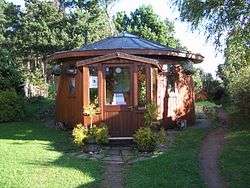
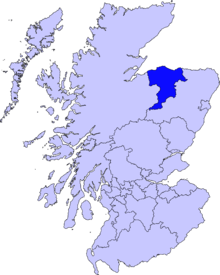
A recent independent study[5] concludes that the residents have the lowest ecological footprint of any community measured so far in the industrialised world and is also half of the UK average.[6] Although the project has attracted some controversy, the growing profile of environmental issues such as climate change has led to a degree of mainstream acceptance of its ecological ethos.[7][8][9]
Beginnings
The October 1982 Conference ‘Building a Planetary Village’[10] hosted by the Findhorn Foundation marked the beginning of serious attempts by the intentional community, which had existed at Findhorn since 1962[11] to demonstrate a human settlement that could be considered sustainable in environmental, social, and economic terms.[12]
The term ‘ecovillage’ later came to be used to describe such experiments and in 1995 the first international conference of ecovillages, Ecovillages and Sustainable Communities for the 21st Century, was held in Findhorn.[13][14]
At first almost all of the activities this involved, such as eco-house construction, a 75 kW Vestas wind turbine and an ecological waste water treatment system were undertaken by the Findhorn Foundation itself, or its trading company New Findhorn Directions Ltd.[15] However, from 1990 onwards a growing number of independent charities, businesses, small sister communities, independent practitioners and community bodies have grown up and significantly extended the size and diversity of ecological projects,[16][17][18] some of which are listed below. As of 2005 the Ecovillage has around 450 members centred around The Park (the main campus on the southern edge of Findhorn), but also based at numerous locations in the nearby town of Forres and elsewhere in Moray. The project supports approximately 300 jobs in the Findhorn/Forres area and provides a total aggregate economic impact in excess of £5 million per annum in the Highlands of Scotland as a whole.[19]
Examples of eco-projects
Ecovillages usually rely on a wide variety of approaches to minimise their ecological footprint. Some of the most important used at Findhorn are listed here although it is important to bear in mind that in any given situation the single largest factor is likely to be the attitudes of the residents rather than the technologies themselves. The national scale is far better researched than the micro scale, and at this level it is easy to observe that countries with similar levels of wealth may have quite different footprints — see for example Chambers (2004).
Ecological building codes
The site has a comprehensive building code that all new buildings are required to meet. It goes far beyond current UK building standards[20] and includes features such as very efficient insulation (typically using products made from recycled paper), non-toxic organic paints, wood preservatives and boarding manufactured without the use of toxic glues or resins and roofing with natural clay tiles.
There are a wide variety of other options used including low-energy light bulbs, 'breathing wall' construction allowing a controlled exchange of air & vapour water conservation features and locally sourced materials. Shared facilities such as laundry, kitchens, lounges etc. are encouraged, thus avoiding unnecessary duplication.[21]
Most new buildings incorporate design features that invite passive solar radiation to reduce building heating needs, such as south-facing windows, conservatories and minimal wall openings on north walls. Sustainably harvested wood provides space heating for many homes both old and new, and an Ecovillage company supplies solar panels for domestic hot water heating to residential and commercial customers throughout the UK.[22] The Highlands and Islands Community Energy Company recently awarded a grant for the installation of ground source heating for the proposed new Moray Arts Centre based at Findhorn.[23]
Simply Build Green — Talbott (1993) — is based on research undertaken at Findhorn Ecovillage and was the UK’s first technical guide to ecological housing.
Eco-architecture
The first new dwelling to be constructed at the Ecovillage was a small house in the round made from a recycled whisky barrel. The idea was later developed and several buildings on this theme were constructed. Other innovative styles include a strawbale house, and an earthship electricity sub-station. Over fifty new houses have now been constructed, some in exotic styles, others more prosaic in appearance. The rigorous building codes contrast with an apparent absence of visual guidelines and the result is a diversity of design rather than a consistent approach to aesthetics.
Living Machine
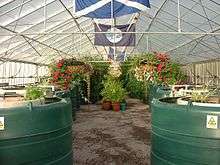
In 1995 Jonathon Porritt opened Europe's first Living Machine (also known as Eco-Restorers in The UK) at The Park campus. This is an ecologically engineered waste water treatment system which is designed to treat sewage from a population of up to 350 people and in common with a number of other such systems[24] also provides a research and educational facility to promote the technology. It was constructed with assistance from the European Union. The invention of Canadian scientist John Todd, they use tanks containing diverse communities of bacteria, algae, micro-organisms, numerous species of plants and trees, snails, fish and other living creatures to treat the water.[24] At the end of the series of tanks, the resulting water is pure enough to be returned to the local water table. Plans to use the water for irrigation have been considered but not implemented to date.[25]
Organic food production
One of the most significant factors in the Ecovillage's low eco-footprint (see below) is its attitude to food production and consumption. Various smallholdings associated with the Ecovillage contribute to a community supported agriculture or 'box' scheme which provides organic produce for the local area, some of it grown using permaculture techniques. This horticulture '"provides more than 70% of the community's fresh food requirements"[26][27] and Phoenix Community Stores, based at the Park, is one of the largest retailers of organic produce in northern Scotland.[28]
Wind park
Another reason for the low ecological impact of the settlement is the presence of four Vestas wind turbines which can generate up to 750 kW. These make the Park settlement net exporters of electricity produced from renewable resources. The first V17 generator was installed in 1989 and three additional V29s were installed in March 2006. The original site was a caravan park and as a result the Ecovillage has its own private electricity grid. Most of the generation is used on-site with any surplus exported to the National Grid.
Eko currency
| Eko | |
| Value: | 1 Eko = 1.00 £ sterling |
| Obverse Design: | Wind turbines |
| Reverse Design: | Low-cost housing |
| Designer: | Posthouse Printing |
| Design Date: | 2006 |
Since 2002 a local currency has been in operation. Launched by Ekopia, the community’s development trust, it is accepted by almost all Ecovillage organisations. There are roughly £20,000 of notes in circulation and issuing them has enabled Ekopia to make low interest loans and donations to support various initiatives including an ecological guest facility, the wind park (above) and the local Youth Project.[29] The current issue, which is due to expire in 2011, is at par with sterling i.e. 1 Eko = £1, and notes are in one, five, ten and twenty denominations.[30]
CIFAL Findhorn
The Findhorn Foundation has been running educational programmes in environmental education since the early 1980s, but a new development occurred in September 2006 with the formal launching of CIFAL Findhorn.[31] This is a new sustainable development training facility, which is a joint initiative between The Moray Council, the Global Ecovillage Network, the Findhorn Foundation and UNITAR.[32]
Ecological Footprint Study
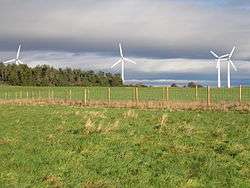
An ecological footprint is an attempt to measure the total environmental impact of human activities in a given area. The results measure the amount of land and water that the population requires to provide the resources they utilise and to absorb their wastes. The calculations used converts this into a measure of land area, global hectares (gha). It is widely accepted[5][33] that the human impact on planet Earth now exceeds the available capacity of natural systems to sustain it, and that western countries typically have a resource usage that ‘would require three planets’ to maintain if every citizen on Earth had a similar impact. In October 2006 preliminary results of the ecological footprint study[5] for the Findhorn Ecovillage undertaken by The Sustainable Development Research Centre of the UHI Millennium Institute in collaboration with the Stockholm Environment Institute confirmed that ecovillages can tread significantly more lightly on the Earth than more conventional communities.
The study found that residents of The Park and the nearby campus of Cluny Hill College have, on average, a footprint of 2.71 hectares per capita, a little over half the UK national average of 5.4 hectares. (By comparison the comparable figure for the United States is 9.5gha, whilst Uzbekistan is rated at the average 'global earthshare' of 1.9gha).[33] Of particular significance are the results relating to food, ‘home and energy' use, and 'consumables and personal possessions' which have 35%, 27% and 44% of the national average respectively. Findhorn residents have an eco-footprint some 13% lower than those at the London eco-housing development, BedZED. The study is also intending to measure the additional impact caused by visitors to the Ecovillage but results are not yet available.
Awards, UN connections and critiques
At a time when resource depletion and global warming are international concerns it is not perhaps surprising that these activities should receive various accolades.
- In September 1995 The Findhorn Ecological Village Project was awarded the 'We the Peoples 50 Communities' award given by the Friends of the United Nations as part of the 50th Anniversary of the UN Celebrations.[4]
- In October 1998 the Ecovillage Project, together with other 100 leadership Initiatives "which are inspiring innovative action on Earth", received Best Practice Designation from the United Nations Centre for Human Settlements — UNCHS (Habitat) and Dubai Municipality.[4]
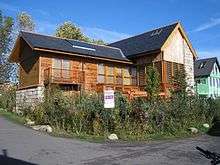
- In September 2000 the conservation charity Trees for Life received the Millennium Marque Award in recognition of its work in helping to restore the Caledonian Forest in Glen Affric.[34]
- The following year the United Nations Environment Programme noted that “most of the problems identified by Agenda 21 have their roots at the local level, therefore UNEP appreciates your significant contribution at the local level to models for holistic and sustainable living in harmony with the environment.”[4]
Various critiques exist in print, although these tend to concentrate on the eclectic spirituality of the Findhorn Foundation rather than the environmental aspects of the Ecovillage. There is a statement of core values for the Ecovillage and its associated community called ‘Common Ground’[35] but other than affirming a commitment to “active spiritual practice” (which is diversely understood and interpreted[15]) it concentrates largely on preferred interpersonal behaviours rather than prescribing a spiritual philosophy. Objections were raised by a local pressure group against the expansion of the wind park[36] but the concerns of local people[1] about the Ecovillage appear to have reduced, partly due to the proactive stance of the ecovillagers themselves,[15] especially perhaps as a result of the gift of some amenity land to a local land trust by Duneland Ltd., an Ecovillage company.[37][38]
While many houses are modest in size some are large, exceeding 200 m² in built area for a single household. Diversity of lifestyle may well be part of any human settlement but the magnitude of such structures hints that the commitment to ‘living lightly on the Earth’ is not as whole-hearted as first appearances may suggest. Nonetheless, working examples of how a western lifestyle might be possible whilst living within the means of the Earth's renewable resources to support it are likely to be of interest at a time when the consensus of mainstream opinion is moving towards the view that ‘business as usual’ may no longer be an option.[7]
See also
- Sustainable development in Scotland
- Renewable energy in Scotland
- Centre for Alternative Technology
- Diggers and Dreamers
Footnotes
- 1 2 Local relations between the Findhorn Foundation and the village of Findhorn have occasionally foundered over inconsiderate use of the word 'Findhorn' to mean either the former or the Ecovillage. See for example Walker (1994), Talk:Findhorn Foundation and also Findhorn (disambiguation).
- ↑ Lovie, R. et al. (2005) Moray Sustainability Handbook. Keith. REAP.
- ↑ "Findhorn Foundation". EcoVillage.org. Retrieved 2012-12-30.
- 1 2 3 4 Burns, B. et al. (2006) CIFAL Findhorn. Findhorn Foundation.
- 1 2 3 Tinsley, S. and George, H. (2006) Ecological Footprint of the Findhorn Foundation and Community. Moray. Sustainable Development Research Centre, UHI Millennium Institute.
- ↑ Edwards, Rob (August 4, 2007). "Findhorn eco-footprint is 'world's smallest'". Sunday Herald. Retrieved 2012-12-30.
A new expert study says the multinational community's ecological footprint is half the UK average. This means Findhorn uses 50% fewer resources and creates 50% less waste than normal.
- 1 2 Stern, Sir Nicholas. (2006) The Economics of Climate Change. London. HM Treasury. ISBN 0-521-70080-9
- ↑ An Inconvenient Truth (2006) Directed by Davis Guggenheim and starring Al Gore. Paramount Classics.
- ↑ Cavendish, C. (31st October 2006) The only debate left on carbon emissions is political. London. The Times newspaper.
- ↑ Scott, M. (2005) A Living Record of the Findhorn Community. Findhorn Foundation.
- ↑ Riddell, C. (1990) The Findhorn Community: Creating a Human Identity for the 21st Century. Findhorn Press.
- ↑ McLaughlin, C. and Davidson, G. (1986) Builders of the Dawn: Community Lifestyles in a Changing World. Sirius.
- ↑ Bang, Jan Martin (2005). Ecovillages. A Practical Guide to Sustainable Communities. Edinburgh: Floris Books. p. 22. ISBN 0-86315-480-8.
- ↑ Dawson, J. (2006) Ecovillages: New Frontiers for Sustainability. Totnes. Green Books. According to this source 400 people attended the conference and a further 300 were turned away.
- 1 2 3 Walker, Alex (Ed). (1994). The Kingdom Within: A Guide to the Spiritual Work of the Findhorn Community. Findhorn Press.
- ↑ EcoVillage Findhorn.
- ↑ Metcalf, B. (2004) The Findhorn Book of Community Living. Findhorn Press.
- ↑ Pewters, V. and Stengel, M. (eds. (2005) Eurotopia: Directory of Intentional Communities and Ecovillages in Europe. Bandua. Okodorf Sieben Linden.
- ↑ Burns, B. Westbrook, S. et al. (2003) Findhorn Foundation Impact Assessment. HIE Moray.
- ↑ Talbott, John. (1993) Simply Build Green. Findhorn Foundation.
- ↑ Talbott, J., and others (2001) The Essential Guide. Findhorn. Titleholders’ Association.
- ↑ AESSolar.
- ↑ HICEC Community Energy News: October 2006.
- 1 2 LTL UK.
- ↑ West, Sarah. (2002) Proposal for Reuse of Sewage Effluent from the Findhorn Living Machine. Sydney Water.
- ↑ Findhorn food. Archived November 9, 2004, at the Wayback Machine.
- ↑ Phœnix Community Stores.
- ↑ Rainbow Bridge. (September 2006). Findhorn Foundation.
- ↑ Eko currency.
- ↑ An Agreement for the opening of CIFAL Findhorn. UNITAR DCP announcement.
- ↑ UN picks Findhorn as site for first UK training centre. (Sat 13 May 2006) Edinburgh. The Scotsman newspaper.
- 1 2 Chambers, N. et al. (2004) Scotland’s Footprint. Best Foot Forward.
- ↑ Trees for Life.
- ↑ Common Ground, the core values of the New Findhorn Association.
- ↑ Action group maps out last chance to halt wind farms. (27.5.2003) Elgin. The Northern Scot newspaper.
- ↑ Duneland.
- ↑ Findhorn village community.
References
- Chambers, N. et al. (2004) Scotland’s Footprint. Best Foot Forward. ISBN 0-9546042-0-2
- Dawson, J. (2006) Ecovillages: New Frontiers for Sustainability. Totnes. Green Books. ISBN 1-903998-77-8
- Findhorn Community. Thompson, William Irwin (Forward). (1968) The Findhorn Garden: Pioneering a New Vision of * Man and Nature in Cooperation. Harper & Row Publishers.
- Gilman, Robert and Diane (1991) Ecovillages and Sustainable Communities. Denmark. Gaia Trust.
- Jackson, H. and Svensson, K. (2002) Ecovillage Living: Restoring the Earth and Her People. Green Books. ISBN 1-903998-16-6
- Metcalf, Bill. (1996) Shared Visions, Shared Lives: Communal Living Around the Globe. Findhorn Press.
- Talbott, John. (1993) Simply Build Green. Findhorn Foundation. ISBN 1-899171-90-8
- Tinsley, S. and George, H. (2006) Ecological Footprint of the Findhorn Foundation and Community. Forres. Sustainable Development Research Centre. UHI Millennium Institute.
- Wackernagel, M. and W. Rees. 1996. Our Ecological Footprint: Reducing Human Impact on the Earth. Gabriola Island, BC: New Society Publishers. ISBN 0-86571-312-X
- Walker, Alex (Ed). (1994) The Kingdom Within: A Guide to the Spiritual Work of the Findhorn Community. Findhorn Press. ISBN 0-905249-99-2
External links
| Wikimedia Commons has media related to Findhorn Foundation. |
- Findhorn Ecovillage Project
- CIFAL Findhorn
- Ekopia, the community’s development trust
- New Findhorn Association - links to diverse Findhorn Ecovillage organisations
- New Findhorn Directions Ltd.
- Trees for Life
Coordinates: 57°39′14″N 3°35′27″W / 57.6539°N 3.5908°W